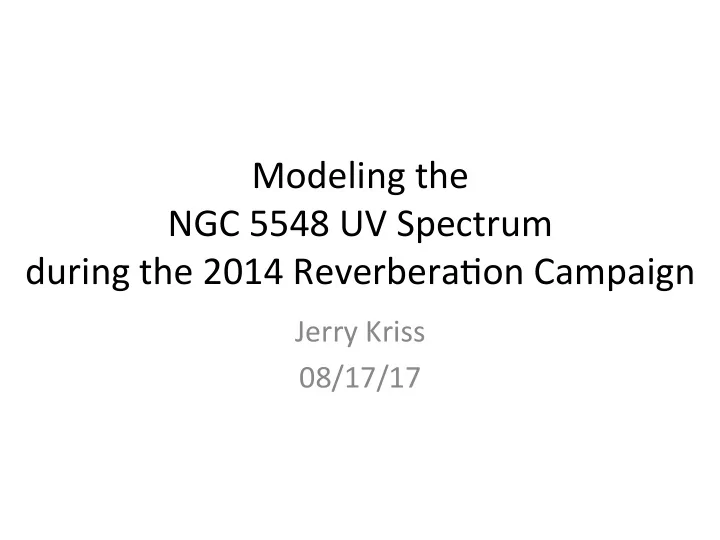

Modeling the NGC 5548 UV Spectrum during the 2014 ReverberaAon Campaign Jerry Kriss 08/17/17
Goals for New Data Products • Obtain an emission model for all 171(+6) spectra from 2013—2014. • Produce absorpAon-corrected, deblended emission-line profiles vs. Ame. • Measure the broad absorpAon strengths in Lyα, N V, Si IV, and C IV vs. Ame. • Measure absorpAon strengths in all six narrow absorpAon components in as many species as possible vs. Ame.
The Model (1) • The model is basically as described in Kaastra et al. (2014) and addiAons for the reverberaAon campaign as described in Paper 1 (de Rosa et al. 2015). • 97 components; 53 free parameters; 123 “tuned” parameters (from fits to the mean spectrum); ~11,600 pts. • Five Gaussian emission components for the most prominent emission lines (Lyα, N V, Si IV, C IV, and He II): – Narrow (~280 km s −1 ) These remain fixed in flux, { width and posiAon. – Intermediate (~800 km s −1 ) – Broad (~3000 km s −1 ) – Medium Broad (~8500 km s −1 ) – Very Broad (~18,000 km s −1 )
The C IV Profile in NGC 5548 Kaastra+14
The Model (2) • ConAnuum is a reddened power law, f λ ~ λ −α , with exAncAon fixed at E(B−V)=0.017, and foreground damped GalacAc Lyα absorpAon with N H =1.45×10 20 . • Broad absorpAon is an asymmetric Gaussian in negaAve flux with the blue wing broader than the red wing. (The broad absorpAon is assumed to absorb all components with equal covering fracAon except the NLR and the ILR.) • Weak, blended Fe II emission is included as the Wills et al. (1985) model using a 4000 km s −1 FWHM.
The Full Spectral Model for NGC 5548 Kaastra+14
Details of the NGC 5548 Spectral Model
The Products (1) • Power-law normalizaAon and index vs. Ame. • Lyα, N V, Si IV, C IV, and He II total fluxes vs. Ame. • Fluxes vs. Ame for some weaker features, e.g., Lyα red bump, C IV red and blue bumps. • Lyα, N V, Si IV, and C IV broad absorpAon EWs and maximum covering factors (assuming saturaAon) vs. Ame. • Narrow absorpAon EWs vs. Ame • The emission spectrum at all wavelengths corrected for all intervening absorpAon vs. Ame.
The Products (2) • The rms spectrum corrected for absorpAon (both broad and narrow). • Cross-correlaAon lags for the deblended total line fluxes (as in Paper 1). • Velocity slices of the Lyα, N V, Si IV, C IV, and He II emission-line profiles vs. Ame (analogous to those in Paper 1), plus their cross-correlaAon lags.
Recommend
More recommend